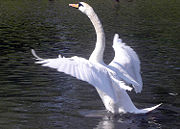Anatidae
| Ducks, geese and swans | ||||||||||||||||
|---|---|---|---|---|---|---|---|---|---|---|---|---|---|---|---|---|
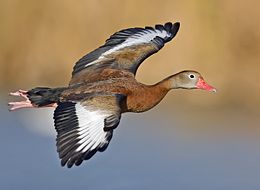 Black-bellied Whistling Duck (Dendrocygna autumnalis)
|
||||||||||||||||
| Scientific classification | ||||||||||||||||
|
||||||||||||||||
| Subfamilies | ||||||||||||||||
|
Anatinae |
Anatidae is the biological family that includes the ducks, geese and swans. The family has a cosmopolitan distribution, occurring on all the world's continents except Antarctica and on most of the world's islands and island groups. These are birds that are evolutionarily adapted for swimming, floating on the water surface, and in some cases diving in at least shallow water. (The Magpie-goose is no longer considered to be part of the Anatidae, but is placed in its own family Anseranatidae.) The family contains around 146 species in 40 genera. They are generally herbivorous, and are monogamous breeders. A number of species undertake annual migrations. A few species have been domesticated for agriculture, and many others are hunted for food and recreation. Five species have become extinct since 1600, and many more are threatened with extinction.
Contents |
Description and ecology
The ducks, geese and swans are small to large sized birds that have a general body plan that is broad and elongated.[1] Diving species vary from this in being rounder. Extant species range in size from the Cotton Pygmy Goose, at as little as 26.5 cm (10.5 inches) and 164 grams (5.8 oz), to the Trumpeter Swan, at as much as 183 cm (6 ft) and 17.2 kg (38 lb). The wings are short and pointed, and supported by strong wing muscles that generate rapid beats in flight. They typically have long necks, although this varies in degree between species. The legs are short and strong and set far to the back of the body, more so in the more aquatic species. Combined with their body shape this can make some species awkward on land, but they are stronger walkers than other marine and water birds such as grebes or petrels. They have webbed feet. The bills of most species are flattened to a greater or lesser extent. These contain serrated lamellae which are particularly well defined in the filter-feeding species.[1]
Their feathers are excellent at shedding water due to special oils. Many of the ducks display sexual dimorphism, with the males being more brightly coloured than the females (although the situation is reversed in species like the Paradise Shelduck). The swans, geese and whistling-ducks lack sexually dimorphic plumage. Anatids are vocal birds, producing a range of quacks, honks, squeaks, and trumpeting sounds, depending on species; the female often has a deeper voice than the male[2].
Anatids are generally herbivorous as adults, feeding on various water-plants, although some species also eat fish, molluscs, or aquatic arthropods. One group, the mergansers, are primarily piscivorous, and have a serrated bill to help them catch fish. In a number of species, the young include a high proportion of invertebrates in their diet, but become purely herbivorous as adults[2].
Breeding
The anatids are generally seasonal and monogamous breeders. The level of monogamy varies within the family, many of the smaller ducks only maintain the bond for a single season and find a new partner the following year, whereas the larger swans, geese and some of the more territorial ducks maintain pair bonds over a number of years. Anatidae are remarkable for being one of the few families of birds that possess a penis;[3] most species are adapted for copulation on the water only. They construct simple nests from whatever material is close to hand, often lining them with a layer of down plucked from the mother's breast. In most species, only the female incubates the eggs. The young are precocial, and are able to feed themselves from birth[2]. One aberrant species, the Black-headed Duck, is an obligate brood parasite, laying its eggs in the nests of gulls and coots. While this species never raises its own young, a number of other ducks will occasionally lay eggs in the nests of conspecifics (members of the same species) in addition to raising their own broods.
Relationship with humans
Duck, eider, and goose feathers and down have long been popular for bedspreads, pillows, sleeping bags and coats. The members of this family also have long been used for food.
Humans have had a long relationship with ducks, geese and swans; they are important economically and culturally to humans, and several duck species have benefited from an association with people. On the flip side some anatids are damaging agricultural pests, and have acted as vectors for zoonosis such as avian influenza.
Since 1600 five species of duck have become extinct due to the activities of humans, and subfossil remains have shown that humans caused numerous extinctions in prehistory. Today many more are considered threatened. Most of the historic and prehistoric extinctions were insular species, these species were vulnerable due to small populations (often endemic to a single island), and island tameness. Evolving on islands that lacked predators these species lost anti-predator behaviours as well as the ability to fly, and were vulnerable to human hunting pressure and introduced species. Other extinctions and declines are attributable to overhunting, habitat loss and modification, as well as hybridisation with introduced ducks (for example the introduced Ruddy Duck swamping the White-headed Duck in Europe). Numerous governments, conservation and hunting organisations have made considerable progress in protecting ducks and duck populations through habitat protection and creation, laws and protection, and captive breeding programmes.
Systematics
While the status of the Anatidae as a family is straightforward, and there is little debate about which species properly belong to it, the relationships of the different tribes and subfamilies within it are poorly understood. The listing in the box at right should be regarded as simply one of several possible ways of organising the many species within the Anatidae; see discussion in the next section.
The systematics of the Anatinae is in a state of flux. Previously divided into six subfamilies, a study of anatomical characters by Livezey[4] suggest that the Anatidae are better treated in nine subfamilies. This classification was popular in the late 1980s to 1990s[5]. But mtDNA sequence analyses[6] indicate that for example the dabbling and diving ducks do not belong in the same subfamily. While there are certainly shortcomings in Livezey's analysis, mtDNA is an unreliable source for phylogenetic information in many waterfowl (especially dabbling ducks) due to their ability to produce fertile hybrids[1], in rare cases possibly even beyond the level of genus (see for example the "Barbary Duck"). Due to the small sample size of many molecular studies available to date, mtDNA results must be considered with caution.
But while a comprehensive review of the Anatidae which unites all evidence into a robust phylogeny is still lacking, the reasons for the confusing data are at least clear: As demonstrated by the Late Cretaceous fossil Vegavis iaai — an early modern waterbird which belonged to an extinct lineage — the Anatidae are an ancient group among the modern birds. Their earliest direct ancestors, though not documented by fossils yet, likewise can be assumed to have been contemporaries with the dinosaurs. The long period of evolution and shifts from one kind of waterbird lifestyle to another have obscured many plesiomorphies, while apomorphies apparently are quite often the result of parallel evolution, for example the "non-diving duck" type displayed by such unrelated genera as Dendrocygna, Amazonetta, and Cairina. For the fossil record, see below.
Alternatively[7], the Anatidae may be considered to consist of 3 subfamilies (ducks, geese, and swans, essentially) which contain the groups as presented here as tribes, with the swans separated as subfamily Cygninae, the goose subfamily Anserinae also containing the whistling ducks, and the Anatinae containing all other clades.
Genera
- Subfamily: Dendrocygninae (One pantropical genus, of distinctive long-legged goose-like birds)
- Dendrocygna, whistling ducks (9 living species)
- Subfamily: Thalassorninae (One genus in Africa, most closely related to the subfamily Dendrocygninae, though also showing convergent similarities to the subfamily Oxyurinae)
- Thalassornis, White-backed Duck
- Subfamily: Anserinae, swans and geese (Three to seven extant genera with 25-30 living species, mainly cool temperate Northern Hemisphere but also some Southern Hemisphere species, with the swans in one genus [two genera in some treatments], and the geese in three genera [two genera in some treatments]. Some other species are sometimes placed herein, but seem somewhat more distinct [see below])
- Cygnus, true swans (7 species, 4 sometimes separated in Olor)
- Anser, grey geese (7 species)
- Chen, white geese (3 species, sometimes included in Anser)
- Branta, black geese (8 living species)
- Subfamily: Stictonettinae (One genus in Australia, formerly included in the Oxyurinae, but with anatomy suggesting a distinct ancient lineage perhaps closest to the Anserinae, especially the Cape Barren Goose)
- Stictonetta, Freckled Duck
- Subfamily: Plectropterinae (One genus in Africa, formerly included in the "perching ducks", but closer to the Tadorninae)
- Plectropterus, Spur-winged Goose
- Subfamily: Tadorninae - shelducks and sheldgeese
(This group of larger, often semi-terrestrial waterfowl can be seen as intermediate between Anserinae and Anatinae. The 1986 revision[4] has resulted in the inclusion of 10 extant genera with about two dozen living species [one probably extinct] in this subfamily, mostly from the Southern Hemisphere but a few in the Northern Hemisphere, but the affiliations of several presumed tadornine genera has later been questioned[8] and the group in the traditional lineup is likely to be paraphyletic)
 Male Common Shelduck
Male Common Shelduck- Pachyanas, Chatham Island Duck (prehistoric)
- Tadorna, shelducks (7 species, one probably extinct) - possibly paraphletic
- Salvadorina, Salvadori's Teal
- Centrornis, Madagascar Sheldgoose (prehistoric, tentatively placed here)
- Alopochen, Egyptian Goose and Mascarene Shelducks (1 living species, 2 extinct)
- Neochen, Orinoco Goose
- Chloephaga, sheldgeese (5 species)
- Hymenolaimus, Blue Duck
- Merganetta, Torrent Duck
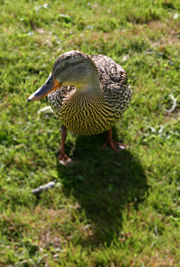 A female mallard duck
A female mallard duck
- Subfamily: Anatinae, dabbling ducks and moa-nalos (The dabbling duck group, of worldwide distribution, were previously restricted to just one or two genera, but had been extended[4] to include 8 extant genera and about 55 living species, including several genera formerly known as the "perching ducks"; mtDNA on the other hand confirms that the genus Anas is over-lumped and casts doubt on the diving duck affiliations of several genera [see below]. The moa-nalos, of which 4 species in 3 genera are known to date, are a peculiar group of flightless, extinct Anatidae from the Hawaiian Islands. Gigantic in size and with massive bills, they were believed to be geese, but have been shown to be actually very closely related to mallard. They evolved filling the ecological niche of turtles, ungulates and other megaherbivores.)
- Anas: wigeons, gadwalls, teals, pintails, mallards, shovelers, etc (40-50 living species, 3 extinct) - paraphyletic
- Lophonetta, Crested Duck
- Speculanas, Bronze-winged Duck
- Amazonetta, Brazilian Duck
- Chelychelynechen, Turtle-jawed Moa-nalo (prehistoric)
- Thambetochen, Large-billed Moa-nalos (2 species, prehistoric)
- Ptaiochen, Small-billed Moa-nalo (prehistoric)
- Subfamily: Aythyinae, diving ducks (Some 15 species of diving ducks, of worldwide distribution, in 2-4 genera; The 1986 morphological analysis[4] suggested that the probably extinct Pink-headed Duck of India, previously treated separately in Rhodonessa, should be placed in Netta, but this has been questioned[9]. Furthermore, while morphologically close to dabbling ducks, the mtDNA data indicates that a treatment as distinct subfamily is indeed correct, with the Tadorninae being actually closer to dabbling ducks than the diving ducks are[10])
- Netta, Red-crested Pochard and allies (4 species, one probably extinct)
- Aythya, pochards, scaups, etc (12 species)
- Subfamily: Merginae, eiders, scoters, sawbills and other sea-ducks
(There are 9 extant genera and some 20 living species; most of this group occur in the Northern Hemisphere, but a few [mostly extinct] mergansers in the Southern Hemisphere)
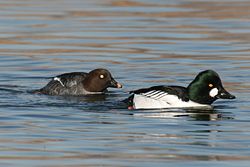 Common Goldeneye couple, male on the right.
Common Goldeneye couple, male on the right.- Chendytes, Diving-geese (prehistoric)
- Polysticta, Steller's Eider
- Somateria, eiders (3 species)
- Histrionicus, Harlequin Duck (includes Ocyplonessa)
- Camptorhynchus, Labrador Duck (extinct)
- Melanitta, scoters (3 species)
- Clangula, Long-tailed Duck (1 species)
- Bucephala, goldeneyes (3 species)
- Mergellus, Smew
- Lophodytes, Hooded Merganser
- Mergus, mergansers (5 living species, one extinct).
- Subfamily: Oxyurinae, stiff-tail ducks (A small group of 3-4 genera, 2-3 of them monotypic, with 7-8 living species)
- Oxyura, stiff-tailed ducks (5 living species)
- Nomonyx, Masked Duck
- Biziura, Musk Ducks (1 living species, provisionally placed here)
- Heteronetta, Black-headed Duck
- Unresolved
 The rare White-winged Wood Duck, a species of unclear affiliation.The largest degree of uncertainty concerns whether a number of genera are closer to the shelducks or to the dabbling ducks. See also the monotypic subfamilies above, and the "perching ducks"
The rare White-winged Wood Duck, a species of unclear affiliation.The largest degree of uncertainty concerns whether a number of genera are closer to the shelducks or to the dabbling ducks. See also the monotypic subfamilies above, and the "perching ducks"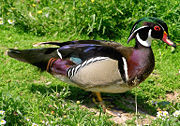 Wood Duck Aix sponsa
Wood Duck Aix sponsa- Coscoroba, Coscoroba Swan - Anserinae or same subfamily as Cereopsis?
- Cereopsis, Cape Barren Goose - Anserinae, Tadorninae, or own subfamily?
- Cnemiornis, New Zealand geese (prehistoric) - as Cereopsis
- Malacorhynchus, Pink-eared ducks (1 living species) - Tadorninae, Oxyurinae or Dendrocheninae?
- Sarkidiornis, Comb Duck - Tadorninae or closer to dabbling ducks?
- Tachyeres, steamer ducks (4 species) - Tadorninae or closer to dabbling ducks?
- Cyanochen, Blue-winged Goose - Tadorninae or more distant clade?
- Nettapus, pygmy geese (3 species) - Anatinae or part of Southern Hemisphere radiation?
- Pteronetta, Hartlaub's Duck - traditionally dabbling ducks, but may be closer to Cyanochen
- Cairina, Muscovy Duck and White-winged Wood Duck (2 species) - traditionally dabbling ducks, but may be paraphyletic, with one species in Tadorninae and the other closer to diving ducks
- Aix, Mandarin Duck and Wood Duck (2 species) - dabbling ducks or Tadorninae?
- Callonetta, Ringed Teal - dabbling ducks or Tadorninae?
- Chenonetta, Maned Duck (1 living species) - dabbling ducks or Tadorninae? Includes Euryanas.
- Marmaronetta, Marbled Duck - Formerly dabbling ducks; actually a diving duck or a distinct subfamily
Species known from bones only
From subfossil bones found on Kauaʻi (Hawaiian Islands), two enigmatic waterfowl are known[11]. The living and assignable prehistoric avifauna of the archipelago contains as Anseriformes Branta geese and their descendants, and the moa-nalos as mentioned above. The following taxa, although certainly new species, cannot be assigned even to subfamily; that Kauaʻi is the oldest of the large Hawaiian Islands, meaning the species may have been evolving in isolation for nearly up to 10 mya (since the Late Miocene), does not help in determining their affinities:
- Long-legged "Shelduck", Anatidae sp. et gen. indet.
- Small-eyed Duck, Anatidae sp. et gen. indet.
Similarly, Wetmore's Goose (Geochen rhuax) from the Big Island of Hawaiʻi, and a gigantic goose-like anatid from Oʻahu are known only from very incomplete and in the former case much damaged bone fragments. The former has been alleged to be a shelduck[12], but this was generally dismissed because of the damage to the material and biogeographic considerations. The long-legged Kauaʻi bird, however, hints at the possibility of a former tadornine presence on the archipelago.
Fossil Anatidae
The fossil record of anatids is extensive, but many prehistoric genera cannot be unequivocally assigned to present-day subfamilies for the reasons given above. Some (such as Eonessa) seem to belong to subfamilies which are completely extinct. For prehistoric species of extant genera, see the respective genus accounts.
Eonessinae - extinct ancient anatids
- Eonessa (Eocene of Utah, USA)
Dendrocheninae - a more advanced relative of the whistling-ducks or a more ancestral relative of stifftail ducks paralleling whistling-ducks; probably extinct but Malacorhynchus might belong here
- Mionetta (Late Oligocene - Middle Miocene of C Europe) - includes "Anas" blanchardi, "A." consobrina, "A." natator, "Aythya" arvernensis
- Manuherikia (Bathans Early/Middle Miocene of Otago, New Zealand)
- Dendrochen (Early - Late? Miocene) - includes "Anas" integra, "A." oligocaena
- Dendrocheninae gen. et sp. indet. (Late Miocene of Argentina) - dendrochenine?
Anserinae
- Cygnavus (Early Oligocene of Kazakhstan - Early Miocene of Germany)
- Cygnopterus (Middle Oligocene of Belgium - Early Miocene of France) - sometimes included in Cygnavus
- Megalodytes (Middle Miocene of California, USA)
- "cf. Megalodytes" (Haraichi Middle Miocene of Annaka, Japan)
- Anserobranta (Late Miocene of C Europe) - includes "Anas" robusta, validity doubtful
- Presbychen (Temblor Late Miocene of Sharktooth Hill, USA)
- Afrocygnus (Late Miocene - Early Pliocene of EC Africa)
- Paracygnus (Kimball Late Pliocene of Nebraska, USA)
- Eremochen (Pliocene)
Tadorninae
- Miotadorna (Bathans Early/Middle Miocene of Otago, New Zealand)
- Tadorninae gen. et sp. indet. (Calvert Middle Miocene of Maryland, USA)
- Balcanas (Early Pliocene of Dorkovo, Bulgaria) - may be synonym of Tadorna or even Common Shelduck
- Anabernicula (Late Pliocene ?- Late Pleistocene of SW and W North America)
- Brantadorna (Middle Pleistocene of Vallecito Creek, USA)
- Nannonetta (Late Pleistocene of Peru)
Anatinae
- Sinanas (Middle Miocene)
- Wasonaka (Middle Pliocene)
Oxyurinae
- Tirarinetta (Pliocene of Australia)
incertae sedis
- Guguschia (Oligocene of Azerbaijan) - Anserinae?
- "Anas" luederitzensis (Kalahari Early Miocene of Lüderitzbucht, Namibia) - Anatinae?
- Dunstanetta (Bathans Early/Middle Miocene of Otago, New Zealand)
- Matanas (Bathans Early/Middle Miocene of Otago, New Zealand)
- Anatidae gen. et sp. indet. MNZ S42797 (Bathans Early/Middle Miocene of Otago, New Zealand)
- "Oxura" doksana (Early Miocene of Dolnice, Czechia)
- "Aythya" chauvirae (Middle Miocene of Sansan, France and Credinţa, Romania) - 2 species
- Anatidae gen. et sp. indet. (Middle Miocene of Nördlinger Ries, Germany) - tadornine?
- Anatidae gen. et sp. indet. (Sajóvölgyi Middle Miocene of Mátraszõlõs, Hungary[13]
- "Anas" meyerii (Middle Miocene of Öhningen, Germany)
- "Anas" velox (Middle - Late? Miocene of C Europe) - Anatinae? May include "A." meyerii
- "Anas" albae (Late Miocene of Polgárdi, Hungary) - formerly in Mergus, Merginae?
- "Anas" isarensis (Late Miocene of Aumeister, Germany) - Anatinae?
- ?Anser scaldii (Late Miocene of Antwerp, Belgium) - anserine or tadornine
- "Anas" eppelsheimensis (Early Pliocene of Eppelsheim, Germany) - Anatinae?
- Aldabranas (Late Pleistocene of Aldabra, Indian Ocean) - Tadorninae or Anatinae
- "Chenopis" nanus - at least 2 taxa, may be living species (Pleistocene of Australia)
Putative or disputed prehistoric anatids are:
- Romainvillia (Late Eocene/Early Oligocene) - Anseranatidae or Anatidae (own subfamily)
- Loxornis (Deseado Early Oligocene of Argentina)
- Paracygnopterus (Early Oligocene of Belgium and England)
- Limicorallus (Indricotherium Middle Oligocene of Chelkar-Teniz, Kazakhstan)
- Teleornis (Deseado Early Oligocene of Argentina)
- Chenornis (Early Miocene) - Anserinae or Phalacrocoracidae
- Paranyroca (Rosebud Early Miocene of Bennett County, USA) - distinct Anatinae subfamily or own family
- Eoneornis (Miocene of Argentina) - Anatinae? A nomen dubium
- Eutelornis (Miocene of Argentina) - Anatinae?
Footnotes
- ↑ 1.0 1.1 1.2 Carboneras (1992)
- ↑ 2.0 2.1 2.2 Todd, Frank S. (1991). Forshaw, Joseph. ed.. Encyclopaedia of Animals: Birds. London: Merehurst Press. pp. 81-87. ISBN 1-85391-186-0.
- ↑ McCracken, Kevin G. (2000): "The 20-cm Spiny Penis of the Argentine Lake Duck (Oxyura vittata)". The Auk 117(3) p.820–825.
- ↑ 4.0 4.1 4.2 4.3 Livezey (1986)
- ↑ E.g. Madge & Burn (1987)
- ↑ Sraml et al. (1996), Johnson & Sorenson (1999)
- ↑ e.g. Terres & NAS (1991)
- ↑ Johnson & Sorenson (1999)
- ↑ Collar et al. (2001)
- ↑ Johnson & Sorenson (1999)
- ↑ Burney et al. (2001)
- ↑ Short (1970)
- ↑ Gál et al. (1998-99)
References
- Burney, David A.; James, Helen F.; Burney, Lida Pigott; Olson, Storrs L.; Kikuchi, William; Wagner, Warren L.; Burney, Mara; McCloskey, Deirdre; Kikuchi, Delores; Grady, Frederick V.; Gage, Reginald II & Nishek, Robert (2001): Fossil Evidence for a Diverse Biota from Kauaʻi and Its Transformation since Human Arrival. Ecological Monographs 71(4): 615-641. doi:10.2307/3100038
- Carboneras, Carles (1992): Family Anatidae (Ducks, Geese and Swans). In: del Hoyo, Josep; Elliott, Andrew & Sargatal, Jordi (eds.): Handbook of Birds of the World (Volume 1: Ostrich to Ducks): 536-629. Lynx Edicions, Barcelona. ISBN 84-87334-10-5
- Collar, N. J.; Andreev, A. V.; Chan, S.; Crosby, M. J.; Subramanya, S. & Tobias, J. A. (eds.) (2001): Pink-headed Duck. In:Threatened Birds of Asia: The BirdLife International Red Data Book: 489-501. BirdLife International. ISBN 0-946888-44-2 HTML fulltext
- Gál, Erika; Hír, János; Kessler, Eugén & Kókay, József (1998-99): Középsõ-miocén õsmaradványok, a Mátraszõlõs, Rákóczi-kápolna alatti útbevágásból. I. A Mátraszõlõs 1. lelõhely [Middle Miocene fossils from the sections at the Rákóczi chapel at Mátraszőlős. Locality Mátraszõlõs I.]. Folia Historico Naturalia Musei Matraensis 23: 33-78. [Hungarian with English abstract] PDF fulltext
- Johnson, Kevin P. & Sorenson, Michael D. (1999): Phylogeny and biogeography of dabbling ducks (genus Anas): a comparison of molecular and morphological evidence. Auk 116(3): 792–805. PDF fulltext
- Livezey, Bradley C. (1986): A phylogenetic analysis of recent anseriform genera using morphological characters. Auk 103(4): 737-754. PDF fulltext DjVu fulltext
- Madge, Steve & Burn, Hilary (1987): Wildfowl : an identification guide to the ducks, geese and swans of the world. Christopher Helm, London. ISBN 0-7470-2201-1
- Short, Lester L. (1970): A new anseriform genus and species from the Nebraska Pliocene. Auk 87(3): 537-543. PDF fulltext
- Sraml, M.; Christidis, L.; Easteal, S.; Horn, P. & Collet, C. (1996): Molecular Relationships Within Australasian Waterfowl (Anseriformes). Australian Journal of Zoology 44(1): 47-58. doi:10.1071/ZO9960047 (HTML abstract)
- Steadman, David William (1999): The Prehistory of Vertebrates, Especially Birds, on Tinian, Aguiguan, and Rota, Northern Mariana Islands. Micronesica 31(2): 319-345. PDF fulltext
- Terres, John K. & National Audubon Society (NAS) (1991): The Audubon Society Encyclopedia of North American Birds. Wings Books, New York. Reprint of 1980 edition. ISBN 0517032880
External links
- Anatidae videos on the Internet Bird Collection
- Anatidae sounds on the xeno-canto collection
